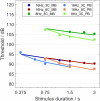Temporal integration of infrasound at threshold
- PMID: 37523364
- PMCID: PMC10389702
- DOI: 10.1371/journal.pone.0289216
Temporal integration of infrasound at threshold
Abstract
Infrasounds are signals with frequencies below the classical audio-frequency range, i.e., below 20 Hz. Several previous studies have shown that infrasound is audible as well, provided that the sound level is high enough. Hence, the sound pressure levels at threshold are much higher than those in the classical audio-frequency range. The present study investigates how the duration and the shape of the temporal envelope affect thresholds of infrasound stimuli in quiet. Two envelope types were considered: one where the duration of the steady state was varied (plateau bursts) and one where the number of consecutive onset-offset bursts was varied (multiple bursts). Stimuli were presented monaurally to human listeners by means of a low-distortion sound reproduction system. For both envelope types, thresholds decrease with increasing duration, a phenomenon often referred to as temporal integration. At the same duration, thresholds for plateau-burst stimuli are typically lower than those for multiple-burst stimuli. The data are well described by a slightly modified version of a model that was previously developed to account for temporal integration in the classical audio-frequency range. The results suggest similar mechanisms underlying the detection of stimuli with frequencies in the infrasound and in the classical audio-frequency range. Since the model accounts for the effect of duration and, more generally, the shape of the envelope, it can be used to enhance the comparability of existing and future datasets of thresholds for infrasounds with different temporal stimulus parameters.
Copyright: © 2023 Friedrich et al. This is an open access article distributed under the terms of the Creative Commons Attribution License, which permits unrestricted use, distribution, and reproduction in any medium, provided the original author and source are credited.
Conflict of interest statement
The authors have declared that no competing interests exist.
Figures






Similar articles
-
A probabilistic Poisson-based model accounts for an extensive set of absolute auditory threshold measurements.Hear Res. 2017 Sep;353:135-161. doi: 10.1016/j.heares.2017.06.011. Epub 2017 Jun 27. Hear Res. 2017. PMID: 28716582
-
Towards a unifying basis of auditory thresholds: the effects of hearing loss on temporal integration reconsidered.J Assoc Res Otolaryngol. 2004 Dec;5(4):436-58. doi: 10.1007/s10162-004-5031-4. J Assoc Res Otolaryngol. 2004. PMID: 15675006 Free PMC article.
-
Hearing at low and infrasonic frequencies.Noise Health. 2004 Apr-Jun;6(23):37-57. Noise Health. 2004. PMID: 15273023 Review.
-
Spectral integration of infrasound at threshold.J Acoust Soc Am. 2020 Mar;147(3):EL259. doi: 10.1121/10.0000897. J Acoust Soc Am. 2020. PMID: 32237799
-
What is infrasound?Prog Biophys Mol Biol. 2007 Jan-Apr;93(1-3):130-7. doi: 10.1016/j.pbiomolbio.2006.07.006. Epub 2006 Aug 4. Prog Biophys Mol Biol. 2007. PMID: 16934315 Review.
References
-
- ISO 7196:1995: Acoustics–Frequency-weighting characteristic for infrasound measurements. International Organization for Standardization, Geneva. 1995. https://www.iso.org/obp/ui/es/#iso:std:iso:7196:ed-1:v1:en.
-
- Down WL. Natural Infrasound of Five Seconds Period. Nature 1967;215: 1469–1470. doi: 10.1038/2151469a0 - DOI
-
- Farges T, Hupe P, Le Pichon A, Ceranna L, Listowski C, Diawara A. Infrasound Thunder Detections across 15 Years over Ivory Coast: Localization, Propagation, and Link with the Stratospheric Semi-Annual Oscillation. Atmosphere 2021;12: 1188. doi: 10.3390/atmos12091188 - DOI
-
- Pilger C, Hupe P, Gaebler P, Ceranna L. 1001 Rocket Launches for Space Missions and Their Infrasonic Signature. Geophys Res Lett. 2021;48: e2020GL092262. doi: 10.1029/2020GL092262 - DOI
Publication types
MeSH terms
LinkOut - more resources
Full Text Sources

